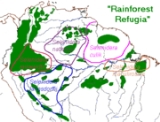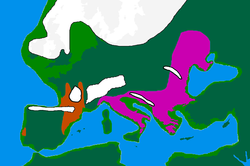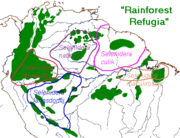
Refugia
Encyclopedia

Relict
A relict is a surviving remnant of a natural phenomenon.* In biology a relict is an organism that at an earlier time was abundant in a large area but now occurs at only one or a few small areas....
population
Population
A population is all the organisms that both belong to the same group or species and live in the same geographical area. The area that is used to define a sexual population is such that inter-breeding is possible between any pair within the area and more probable than cross-breeding with individuals...
of a once more widespread species. This isolation (allopatry) can be due to climatic changes, geography, or human activities such as deforestation
Deforestation
Deforestation is the removal of a forest or stand of trees where the land is thereafter converted to a nonforest use. Examples of deforestation include conversion of forestland to farms, ranches, or urban use....
and over-hunting. Present examples of refuge species are the mountain gorilla
Mountain Gorilla
The Mountain Gorilla is one of the two subspecies of the Eastern Gorilla. There are two populations. One is found in the Virunga volcanic mountains of Central Africa, within three National Parks: Mgahinga, in south-west Uganda; Volcanoes, in north-west Rwanda; and Virunga in the eastern Democratic...
, isolated to specific mountains in central Africa, and the Australian Sea Lion
Australian Sea Lion
The Australian Sea Lion , also known as the Australian Sea-lion or Australian Sealion, is a species of sea lion that breeds only on the south and west coasts of Australia...
, isolated to specific breeding beaches in South Australia
South Australia
South Australia is a state of Australia in the southern central part of the country. It covers some of the most arid parts of the continent; with a total land area of , it is the fourth largest of Australia's six states and two territories.South Australia shares borders with all of the mainland...
due to over hunting. This isolation, in many cases, can be seen as only a temporary state; however, some refugia may be long-standing, thereby having many endemic species, not found elsewhere, which survive as relict populations.
In anthropology
Anthropology
Anthropology is the study of humanity. It has origins in the humanities, the natural sciences, and the social sciences. The term "anthropology" is from the Greek anthrōpos , "man", understood to mean mankind or humanity, and -logia , "discourse" or "study", and was first used in 1501 by German...
, refugia often refers specifically to Last Glacial Maximum refugia
Last Glacial Maximum refugia
Last Glacial Maximum refugia were places where people survived during the last glacial period in the northern hemisphere.Sub-Saharan Africa and Australia were not affected by the glaciation and the Americas and New Zealand had no humans at that time...
, where some ancestral human populations may have been forced back to glacial refugia, similar small isolated pockets in the face of the continental ice sheet
Ice sheet
An ice sheet is a mass of glacier ice that covers surrounding terrain and is greater than 50,000 km² , thus also known as continental glacier...
s during the last ice age
Last Glacial Maximum
The Last Glacial Maximum refers to a period in the Earth's climate history when ice sheets were at their maximum extension, between 26,500 and 19,000–20,000 years ago, marking the peak of the last glacial period. During this time, vast ice sheets covered much of North America, northern Europe and...
. Going from west to east, suggested examples include the Franco-Cantabrian region (in northern Iberia
Iberian Peninsula
The Iberian Peninsula , sometimes called Iberia, is located in the extreme southwest of Europe and includes the modern-day sovereign states of Spain, Portugal and Andorra, as well as the British Overseas Territory of Gibraltar...
), the Italian
Italy
Italy , officially the Italian Republic languages]] under the European Charter for Regional or Minority Languages. In each of these, Italy's official name is as follows:;;;;;;;;), is a unitary parliamentary republic in South-Central Europe. To the north it borders France, Switzerland, Austria and...
, and Balkan peninsulas, Ukrainian LGM refuge
Ukrainian LGM refuge
The Late Glacial Maximum , or Tardiglacial , is defined primarily by climates in the northern hemisphere warming substantially, causing a process of accelerated deglaciation following the Last Glacial Maximum...
, and the Bering land bridge
Bering land bridge
The Bering land bridge was a land bridge roughly 1,000 miles wide at its greatest extent, which joined present-day Alaska and eastern Siberia at various times during the Pleistocene ice ages. Like most of Siberia and all of Manchuria, Beringia was not glaciated because snowfall was extremely light...
.
Speciation

Jürgen Haffer
Jürgen Haffer was a German ornithologist, biogeographer, and geologist. He is most remembered for his theory of Amazonian forest refugia during the Pleistocene that would have contributed to speciation and the diversification of the biota.At the age of 13 he had found a dead bird with a ring and...
first proposed the concept of refugia to explain the biological diversity of bird populations in the Amazonian river basin. Haffer suggested that climatic change in the late Pleistocene
Pleistocene
The Pleistocene is the epoch from 2,588,000 to 11,700 years BP that spans the world's recent period of repeated glaciations. The name pleistocene is derived from the Greek and ....
led to reduced reservoirs of habitable forests in which populations become allopatric. Over time, this led to speciation
Speciation
Speciation is the evolutionary process by which new biological species arise. The biologist Orator F. Cook seems to have been the first to coin the term 'speciation' for the splitting of lineages or 'cladogenesis,' as opposed to 'anagenesis' or 'phyletic evolution' occurring within lineages...
- populations of the same species which found themselves in different refugia evolved differently, creating parapatric sister-species. As the Pleistocene ended, the arid conditions gave way to the present humid rainforest environment, reconnecting the refugia.
Scholars have since expanded the idea of this mode of speciation and used it to explain population patterns in other areas of the world, such as Africa
Africa
Africa is the world's second largest and second most populous continent, after Asia. At about 30.2 million km² including adjacent islands, it covers 6% of the Earth's total surface area and 20.4% of the total land area...
and North America
North America
North America is a continent wholly within the Northern Hemisphere and almost wholly within the Western Hemisphere. It is also considered a northern subcontinent of the Americas...
. Theoretically, current biogeographical patterns can be used to infer past refugia: where several unrelated species follow concurrent range
Range (biology)
In biology, the range or distribution of a species is the geographical area within which that species can be found. Within that range, dispersion is variation in local density.The term is often qualified:...
patterns, the area may have been a refugium. But this model of speciation
Speciation
Speciation is the evolutionary process by which new biological species arise. The biologist Orator F. Cook seems to have been the first to coin the term 'speciation' for the splitting of lineages or 'cladogenesis,' as opposed to 'anagenesis' or 'phyletic evolution' occurring within lineages...
remains highly controversial.
Simple environment examples of temperature
One can provide a simple explanation of refugia involving core temperatures and exposure to sunlight. In the northern hemisphereNorthern Hemisphere
The Northern Hemisphere is the half of a planet that is north of its equator—the word hemisphere literally means “half sphere”. It is also that half of the celestial sphere north of the celestial equator...
, north-facing sites on hills or mountains, and at higher elevations count as cold sites. The reverse are sun- or heat-exposed, lower-elevation, south-facing sites: hot sites. (The opposite directions apply in the southern hemisphere
Southern Hemisphere
The Southern Hemisphere is the part of Earth that lies south of the equator. The word hemisphere literally means 'half ball' or "half sphere"...
.) Each site becomes the refugium, one as a "cold-surviving refugium", and the other for the 'hot-surviving refugium'. Canyons, with deep hidden areas, or the opposite of hillsides, mountains, mesas, etc, or other exposed areas, lead to these separate types of refugia. A concept not often referenced is that of "sweepstakes colonization": when a dramatic ecological event occurs, for example a bolide strike, and global, multiyear effects occur, the sweepstake-winning species happens to already be living in a fortunate site, and their environment is rendered even more advantageous, as opposed to the "losing" species, which immediately fail to reproduce.
See also
- BiogeographyBiogeographyBiogeography is the study of the distribution of species , organisms, and ecosystems in space and through geological time. Organisms and biological communities vary in a highly regular fashion along geographic gradients of latitude, elevation, isolation and habitat area...
- Population biologyPopulation biologyPopulation biology is a study of populations of organisms, especially the regulation of population size, life history traits such as clutch size, and extinction...
- Population geneticsPopulation geneticsPopulation genetics is the study of allele frequency distribution and change under the influence of the four main evolutionary processes: natural selection, genetic drift, mutation and gene flow. It also takes into account the factors of recombination, population subdivision and population...
- Fisheries Refugia
- Sky islandSky islandSky islands are mountains that are isolated by surrounding lowlands of a dramatically different environment, a situation which, in combination with the altitudinal zonation of ecosystems, has significant implications for natural habitats. Endemism, vertical migration, and relict populations are...
- TepuiTepuiA tepui , or tepuy, is a table-top mountain or mesa found in the Guiana Highlands of South America, especially in Venezuela. The word tepui means "house of the gods" in the native tongue of the Pemon, the indigenous people who inhabit the Gran Sabana....
- Last Glacial Maximum refugiaLast Glacial Maximum refugiaLast Glacial Maximum refugia were places where people survived during the last glacial period in the northern hemisphere.Sub-Saharan Africa and Australia were not affected by the glaciation and the Americas and New Zealand had no humans at that time...
- Zomia (geography)Zomia (geography)Zomia is a geographical term coined in 2002 by historian Willem van Schendel of the University of Amsterdam to refer to the huge massif of mainland Southeast Asia that has historically been beyond the control of governments based in the population centers of the lowlands...
- Genetic driftGenetic driftGenetic drift or allelic drift is the change in the frequency of a gene variant in a population due to random sampling.The alleles in the offspring are a sample of those in the parents, and chance has a role in determining whether a given individual survives and reproduces...
- Drought refugeDrought refugeA drought refuge is a site that provides permanent fresh water or moist conditions for plants and animals, acting as a refuge habitat when surrounding areas are affected by drought and allowing ecosystems and core species populations to survive until the drought breaks...

